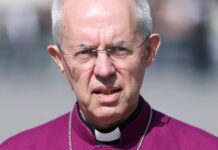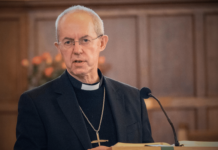For the last fifty years the Anglican Communion has been divided over the doctrine of marriage. That came to an end in April 2023 when Global South Anglicans declared they’d had enough. Anglican bishops representing 85 percent of the Anglican Communion decided that Canterbury’s same-sex blessings were attempts to sanctify “sin” and determined to “reset the Communion on its biblical foundations.”
Protestants have always declared the Bible to be their final authority, but they have divided into thirty thousand denominations that differ on how to interpret it. The same problem of interpretation is now dividing global Anglicanism.
Unlike many evangelicals, Anglicans have always said that tradition should play a role in their interpretation of the Bible. But the nature of that role is now dividing global Anglicans in ways that, ironically, threaten to return otherwise orthodox Anglicans to the liberal Protestant camp they have sought to escape.
In their battles with liberal Anglicans over the last half-century, orthodox Anglicans have continually decried liberal departures from biblical teaching about marriage and sexuality. These efforts culminated in the passage of Resolution 1.10 at the 1998 Lambeth Conference, which rejected “homosexual practice as incompatible with Scripture” and proclaimed “marriage between a man and a woman in lifelong union” to be “the teaching of Scripture.”
When the Global Anglican Future Conference (GAFCON) was created in 2008, its Jerusalem Statement reaffirmed the doctrine of Resolution 1.10. It also articulated its understanding of how to relate tradition to Scripture: The Bible is to be “taught and obeyed in its plain and canonical sense, respectful of the church’s historic and consensual reading” (emphasis added).
While Global South Anglicans said they should respect tradition, there was none of that language in their April 2023 declaration of independence from Canterbury. Instead, the Bible alone was declared “the rule of our lives” and the “final authority in the church.” What happened to the Church’s “historic and consensual reading”?
Several clues came later that year when Rev. Dr. Ashley Null gave a public lecture on the relation between tradition and Scripture at the leading seminary of the Anglican Church in North America (ACNA), which is formally allied with GAFCON. Null’s lecture was significant because he helped write the Jerusalem Statement and is a principal theological advisor to GAFCON. Oddly, he is also a priest and canon theologian in The Episcopal Church (TEC).
Null hinted at the “respect” accorded tradition in Lambeth 1.10 when he declared that Scripture “is to be read in community and continuity with the writings of Christians who have gone before, in particular, the Creeds, the first four general councils, and the Thirty-Nine Articles [of the Church of England in 1571].” He went on to say that English Reformers William Tyndale, Thomas Cranmer, Hugh Latimer, and Nicholas Ridley “indisputably held that no matter how much Tradition could help illuminate the Bible’s meaning, ultimately it was its own final interpreter.”
Like the magisterial Reformers Martin Luther and John Calvin, these English Reformers often used the term “sola scriptura” (the Bible alone) for the authority of the Bible over against late medieval teachings that seemed to violate the historic Church’s biblical teaching found in the councils and creeds and Church Fathers such as Augustine and Chrysostom. In practice, then, for the English Reformers sola scriptura meant the primacy of Scripture when read within the Church’s great traditions, which has been aptly called prima scriptura.
They recognized that the real battle was not over the authority of Scripture but how to interpret it. This struggle over the Bible’s interpretation started early in the history of Christianity. One of the first great heresies afflicting the Church came from the teachings of Arius, a learned presbyter in ancient Alexandria who taught the final authority of the Bible without the help of tradition—nuda scriptura, if you will. Arius used Scripture verses (such as Jesus’s statement, “The Father is greater than I”) to support his contention that Jesus was more than an ordinary man but less than fully God.
Athanasius responded in an epistle to the African bishops that we need Church tradition to interpret the Bible properly. Only “the sound Faith which Christ gave us, the Apostles preached, and the Fathers, who met at Nicaea from all this world of ours, have handed down,” can enable us to interpret Scripture properly (emphasis added). The Fathers at Nicaea taught that Christ is homoousios—of the same nature as the Father. Athanasius pointed out that while this Greek word is not in the Bible, its concept is, and we need the Church’s tradition to know this.
Hilary of Poitiers, who has been called the Athanasius of the West, fought similar theological battles in the same era over the nature of Christ and used the same method in his treatise On the Trinity, appealing to “the faith of the Church, inspired by the teaching of the Apostles.”
The Anglican Reformers of the sixteenth century taught a similar theological method. In the same year that Anglican bishops produced the Thirty-Nine Articles, they imposed a rule (Canon 6) on Anglican priests that they were to “teach nothing in the way of a sermon . . . save what is agreeable to the teaching of the Old or New Testament; and what the catholic fathers and ancient bishops have collected from” the Scriptures.
Archbishop of Canterbury Richard Bancroft, commending the works of Bishop John Jewel, another Anglican Reformer, wrote in 1609: “This is and hath been the open profession of the Church of England, to defend and mainteine no other Church, Faith, and Religion, than that which is truly Catholike and Apostolike, and for such warranted, not only by the written word of God, but also by the testimonie and consent of the ancient and godly Fathers.”
The Anglican pattern of the sixteenth century, then, was not to think that the Bible can interpret itself without guidance from the ancient Fathers of the Church. In fact, they wrote, it is to the undivided Church of the first millennium and its Fathers that we must turn for proper understanding of the Bible. They eschewed the notion of a Bible whose interpretation could be disconnected from the Church that produced it. They recognized that the human interpreter of the Bible must think within the Church’s historic consensus if he is to interpret the Bible properly.
Null cites the late American Bishop John Rodgers for support. Rodgers, who proposed a new Anglican Communion in 2008 because of Canterbury’s looming heresies, agreed that the Reformation’s sola scriptura slogan never meant a Bible isolated from tradition, but that “all aspects of tradition are to be tested by what is taught in Scripture.” This means, in Null’s words, “letting the Bible interpret itself.”
These Anglicans remind their liberal comrades that the Bible is not a human response to religious experience, as liberal theology has taught since the Enlightenment, but is the written Word of God to which we must submit.
But if the English Reformers used sola scriptura while deferring to the great Fathers of the Church and its ecumenical councils and creeds, is Null proposing the same? That today’s Anglicans should defer to historic Church teachings in their interpretations of the Bible? Telling us that we are to “let the Bible interpret itself” and use the Bible to interpret “all aspects of tradition” is not quite the same.
In fact, the statements suggest that the Bible is self-interpreting—that there is no need for testing our interpretations. Unless, of course, we can assume the doctrine of Immaculate Interpretation.
The problem with thinking that we can let the Bible “interpret itself” is that we naively presume that we the interpreters are without our own traditions. Then we unwittingly read our own cultural traditions—such as the American tradition of individualism—into the Bible. To wit, many Protestants think the basic message of the Bible is about “me and Jesus” and getting to heaven, and that church is unnecessary and often an obstacle. Yet Jesus said he came to “build my Church” (Matt. 16:18), and Paul called the Church the “pillar and foundation of the truth” (1 Tim. 3:15). He also said the Church is the Body of Christ (1 Cor. 12:27), which implies that we cut ourselves off from Christ if we stop participating in church.
It was the historic Church and its Fathers that taught this to untold generations of Christians. Irenaeus spoke of the Church as our “ladder of ascent to God.” And the great Father and martyr Cyprian famously declared, “He can no longer have God for his Father who has not the Church for his mother.”
One of the most stunning examples of Anglicans rejecting tradition when interpreting the Bible is their widespread practice of women’s ordination. This started in TEC in the 1970s despite thousands of years of Jewish and Christian tradition against it. Now there are female clergy in several GAFCON provinces—not only women deacons and priests but also bishops. In 2017 the college of bishops in the ACNA acknowledged that the ordination of women to the priesthood is an “innovation” in the tradition and that there is “insufficient warrant” in Scripture for this practice. Yet the ACNA and GAFCON continue to proclaim that they are biblical communions dedicated to the final authority of Scripture.
This raises two questions for Null and Anglican leaders. If Scripture interprets itself, then why are Anglicans who agree on the final authority of Scripture deeply divided on women’s ordination? And how can this impasse be resolved using a sola scriptura hermeneutic without the guidance of tradition?
It was no surprise that after TEC opened the door to women’s ordination in 1976, it ordained its first openly gay man to the priesthood the following year, and its first gay bishop in 2003. The thinking was consistent: If tradition and the plain sense of Scripture can be ignored on Holy Orders, why not on marriage and sexuality? Especially when contemporary calls for “justice” and “equality” demand that what society recognizes must be replicated in the churches?
GAFCON and the ACNA insist they still hold to the final authority of Scripture. But they are finding it increasingly difficult to defend their sense of biblical authority when they have already rejected not only the universal consensus in tradition on Holy Orders but also the plain sense of Scripture: “I do not permit a woman to . . . have authority over men. . . . A bishop must be the husband of one wife. . . . Let deacons be the husbands of one wife” (1 Tim. 2:12; 3:1–2; 3:12). We might ask: Is Scripture not self-interpreting here?
The pattern we saw over the last fifty years, where defiance of tradition and Scripture on Holy Orders leads to rejection of tradition and Scripture on marriage, is beginning to play out. Fulcrum, an evangelical group in the Church of England that believes the Bible is its “supreme authority” to “judge [the Church], its thinking, and its traditions,” features on its website an article that praises Pope Francis’s Fiducia Supplicans declaration, which authorizes “blessings” for same-sex couples. Luminous Anglican was an ACNA parish in Tennessee that announced its intention to disaffiliate after its promotion of LGBT Pride events and gay marriage was exposed. This parish is following the lead of other gay-affirming congregations that once were ACNA but have joined TEC where their hermeneutic is more at home.
And in GAFCON, the significance of sexual difference—critical to both Holy Orders and marriage—is being challenged. In January 2024, after meetings organized and funded with help from TEC, six female African bishops (three from GAFCON) issued a communiqué declaring that Christianity is “essentially a ‘women’s movement,’” and among its “most urgent tasks” is to review “the presence of gender-related issues in liturgical celebrations.”
All these churches claim the final authority of Scripture. Respect for tradition seems to play a marginal role, noted where it agrees with cultural presumptions but ignored where it doesn’t. If tradition is always being tested but never tests biblical interpretation, the meaning of the Bible can be missed.
Which brings us back to Null’s address on Anglican theological method. One wonders if his confidence that the Bible interprets itself in a self-evident manner—without careful deference to patristic traditions of interpretation—is related to his teaching about the gospel, the Bible, and Anglicanism. The gospel, he argues, is summed up in the Lutheran doctrine of “justification by faith,” which is the “glorious exchange” whereby “God took upon himself the sins of a rebellious world, so that at his initiative and as his free gift, humanity could be credited with his righteousness and receive the right to stand in his presence.” Any other version of justification not based on God’s freely given love amounts to “earning love through our performance,” which is “not a message that young people today can bear.” But justification by faith, defined by the forensic or legal declaration of forgiveness, is “the essence of the Gospel” and “the essence of Anglicanism” because it best expresses the message of the Bible.
Is it correct to suggest that justification by faith alone is the center of the gospel? Anglican theologian Alister McGrath has published the definitive tome on the subject of justification, Iustitia Dei: A History of the Christian Doctrine of Justification, and in that magisterial study argues that while justification is one aspect of the biblical good news, it is far from its center. “Justification” is a word that comes from the lawcourt to describe in a legal way what happens when the holy God accepts unholy sinners into his family. But while this is glorious and indispensable to our understanding of the gospel, by itself it is neither the heart of the gospel nor the center of the biblical story. The good news of the gospel is that the God of Israel has finally sent his Messiah Jesus as Lord and Savior to die for our sins and be raised for our justification so that we can walk in newness of life through the Church and its sacraments on the pilgrim road to the New Jerusalem.
The heart of the biblical story, according to McGrath, is not justification but salvation. Justification is one significant part of salvation, but not its most critical part. As Jonathan Edwards taught, another word for the biblical story of salvation is “redemption,” which starts with being placed into the family of Abraham, and “justification” describes the legal dimension of this placement. But redemption continues after this legal acceptance, with every soul being prepared for heaven by gradually conforming to the likeness of Jesus (sanctification). Then after death God gives the soul eternal glory (glorification). That’s why Paul says God has made Jesus our “righteousness [using the same Greek root as in ‘justification’] and sanctification [literally ‘holiness’] and redemption [which here suggests glorification]” (1 Cor. 1:30). It is why Paul tells the Galatians he “suffers birth pains until Christ is formed in you” (Gal. 4:19), suggesting a gradual process of forming the character of Christ within us, that is, the long growth of sanctification until we reach glory (1 Cor. 15:41–42).
These steps for the individual soul are still only part of redemption. The biblical story of salvation is also corporate and cosmic. It tells of the defeat of evil, the restoration of all that was ruined by the Fall, uniting all things in the Messiah, perfecting the beauty of God’s people, the Church, and promoting the glory of God throughout. In the face of all this, it is apparent that to say justification by faith is the whole story of the gospel or the Bible is to miss the forest for a clump of trees.
Nor does justification by faith represent the essence of Anglicanism. For centuries Anglicans have said the Book of Common Prayer is at the heart of their life and worship, and the 1662 edition has been its official version for most of the time since. In its preface on “the service of the Church” we are told that “the ancient Fathers” ordained “Common Prayers in the Church” for the purpose of “a great advance of godliness” so that the Christian might “profit more and more in the knowledge of God, and . . . be more inflamed with the love of his true religion.”
Justification by faith is the beginning of the Christian life, but the Prayer Book is about the entire pilgrimage of faith, a journey of growth in knowledge of God and holiness. Null’s centering of forensic justification risks what the 2019 Prayer Book preface warns against: “proclaiming a gospel of individual affirmation rather than of personal transformation and sanctification.”
Read it all in First Things










